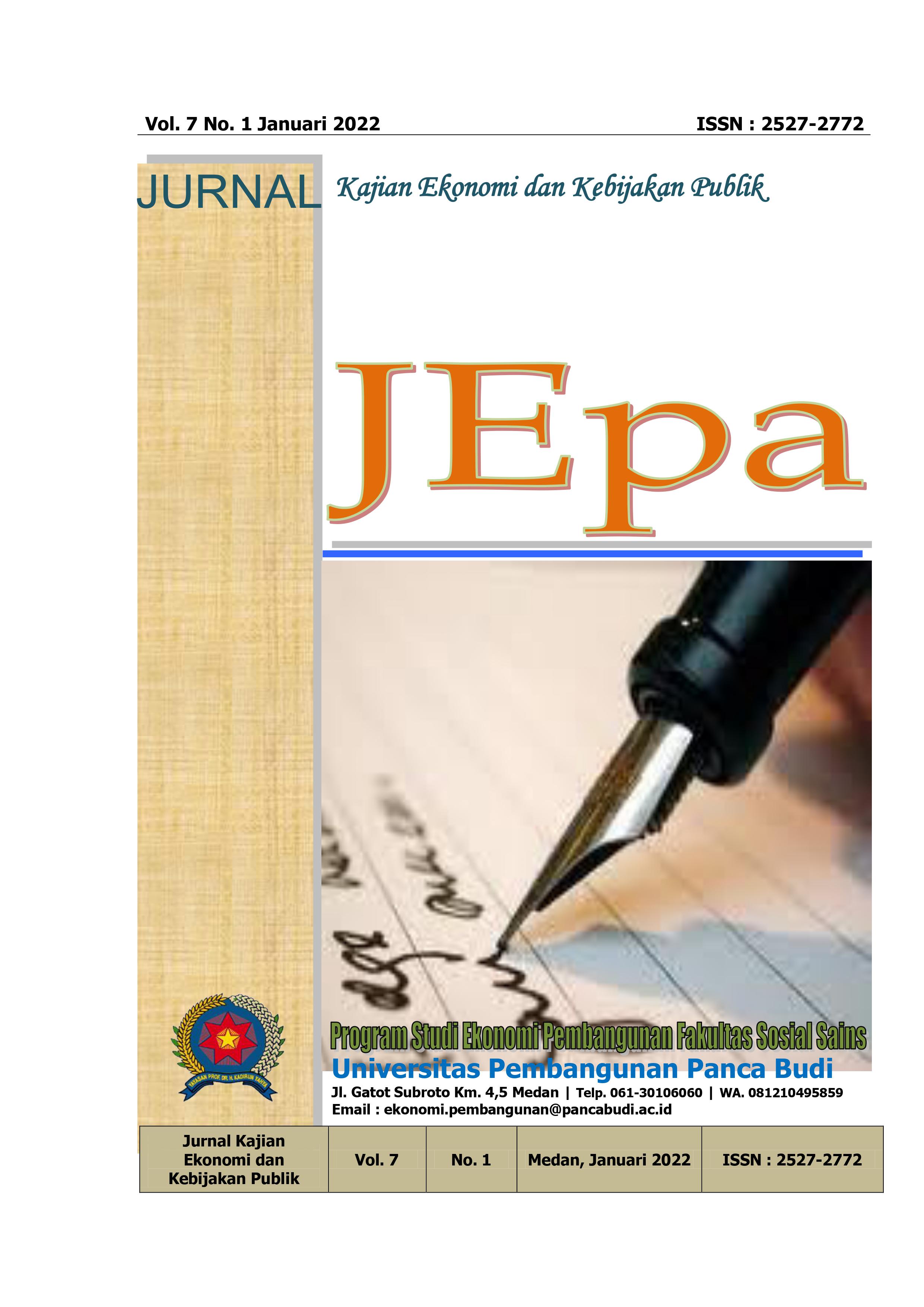ANALISIS DAMPAK KEBIJAKAN MAKROEKONOMI TERHADAP PERTUMBUHAN EKONOMI INKLUSIF PROVINSI DI PULAU SUMATERA TAHUN 2015-2020
Abstract
During 2015-2020, Sumatra experienced fluctuating economic growth. Economic growth in Sumatra is in line with changes in other macroeconomic measures. The macro measures include poverty, inequality, and the unemployment rate. That condition indicates that there is inclusive economic growth in this Western Indonesia. Inclusive growth is important to help in reducing poverty, income inequality, and unemployment rate as well. Nevertheless, that inclusive growth is unequal between one and another region in Sumatra. So, this study aims to analyze the impact of macroeconomic policies to inclusive growth in Western Indonesia 2015-2020. The analytical tool used in this research is panel data regression analysis using the Eviews10. Then, the best panel data regression model is the fixed effect model (FEM) estimated cross section weights. The results of the analysis show that government spending on education, inflation, economic openness, fiscal autonomy index (IKFD), and gross fixed capital formation (PMTB) have a positive and significant effect on inclusive growth.
References
Anand, R., Mishra, M. S., & Peiris, S. J. (2013). Inclusive growth: Measurement and determinants (Issues 13–135). International Monetary Fund.
Azwar, A. (2016). PERTUMBUHAN INKLUSIF DI PROVINSI SULAWESI SELATAN DAN FAKTOR-FAKTOR YANG MEMPENGARUHINYA. Jurnal BPPK: Badan Pendidikan Dan Pelatihan Keuangan, 9(2), 216–242.
BPK (2021). Laporan Hasil Pemeriksaan Atas Laporan Keuangan Pemerintah Pusat Tahun 2020, Nomor: 26f/LHP/XV/05/201.
Claus, I., Vazquez, J.M., & Vulovic, V. (2012). Government fiscal policies and redistributions in Asian countries. ADB Economics Working Paper Series, No.3, 10 October 2012. Filipina: Asian Development Bank.
Davtyan, K. (2015). Income inequality and monetary policy. November 15, 2015.
Estrada, G., Lee, S. H., & Park, D. H. (2014). Fiscal policy for inclusive growth: An overview. ADB Economics Working Paper Series No.424, December 2014. Filipina: Asian Development Bank.
Greene, William H. (2003). Econometric Analysis (Fifth Edition). New Jersey: Prentice Hall.
Gujarati, Damodar N. (2004). Basic Econometrics (Fourth Edition). Singapura: Mc Graw Hill.
Hapsari, S. A. D., Hutagaol, M. P., & Asmara, A. (2013). Pertumbuhan Inklusif: Fenomena Pertumbuhan Inklusif Di Kawasan Indonesia Bagian Barat Dan Indonesia Bagian Timur. Jurnal Ekonomi Dan Kebijakan Pembangunan, 2(2), 85–112. https://doi.org/10.29244/jekp.2.2.85-112.
Hur, S. K. (2014). Government spending and inclusive growth in developing Asia. ADB Economics Working Paper Series, No.415, November 2014. Filipina: Asian Development Bank.
Khan et al. (2016). Measurement and Determinants of Inclusive Growth: A Case Study of Pakistan (1990-2012). The Pakistan Development Review. 55(4), 455-466. https://doi.org/10.30541/v55i4I-IIpp.455-466
Kusumaningrum, S., & Yuhan, R. J. (2019). Pertumbuhan Ekonomi Provinsi di Indonesia Berdasarkan Indeks Komposit Pertumbuhan Inklusif dan Faktor yang Memengaruhinya [Economic Growth of Provinces in Indonesia Based on Inclusive Growth Composite Index and The Influence Factors]. Jurnal Ekonomi & Kebijakan Publik, 10(1), 1–17.
Lipsey R.G And Steiner, (1981). Economics, Sixth edition. Harper and Row publisher. New York
Mallik, G., & Chowdhury, A. (2001). Inflation and economic growth: evidence from four South Asian countries. Asia-Pacific Development Journal, Vol. 8, No. 1, June 2001.
McKinley, T. (2010). Inclusive Growth Criteria and Indicators: An Inclusive Growth Index for Diagnosis of Country Progress.
Mushkin, S. (1962). Health as an investment. Journal of Political Economy, 70 (5), Part 2: Investment in Human Beings (Oct. 1962), pp. 129-157. The University of Chicago Press Journal, http://www.jstor.org/stable/1829109, diakses 22 Agustus 2021.
Pratiwi, I. E. & Ismal, R. (2017). Analisis Dampak Kebijakan Fiskal dan Sasaran Akhir Kebijakan Moneter terhadap Pertumbuhan Inklusif di Indonesia, Malaysia, Qatar dan Saudi Arabia. Jurnal Middle East and Islamic Studies, 4(1), 73-91.
Schultz, T.W. (1961). Investment in human capital. American Economic Review, 51, 1 – 17.
Singh, K. D. (2017). Inclusive Growth and Poverty Reduction: A Case Study of India, Indian Journal of Public Administration, 63(4), 579-594.
Sitorus, A. V. Y., & Arsani, A. M. (2018). A Comparative Study of Inter-Provincial Inclusive Economic Growth in Indonesia 2010-2015 with Approach Methods of ADB, WEF, and UNDP. Jurnal Perencanaan Pembangunan: The Indonesian Journal of Development Planning, 2(1), 64-77.
Sholihah, D.H.A. (2014). Pertumbuhan inklusif: Fakor-faktor yang mempengaruhi dan dampaknya terhadap pertumbuhan kelas menengah di Indonesia. Tesis. Bogor: IPB.
World Bank. (2018). The little data book on financial inclusion 2018. Washington, DC: World Bank. Diakses 25 Agustus 2021 dari https://openknowledge.worldbank.org/handle/10986/29654.




